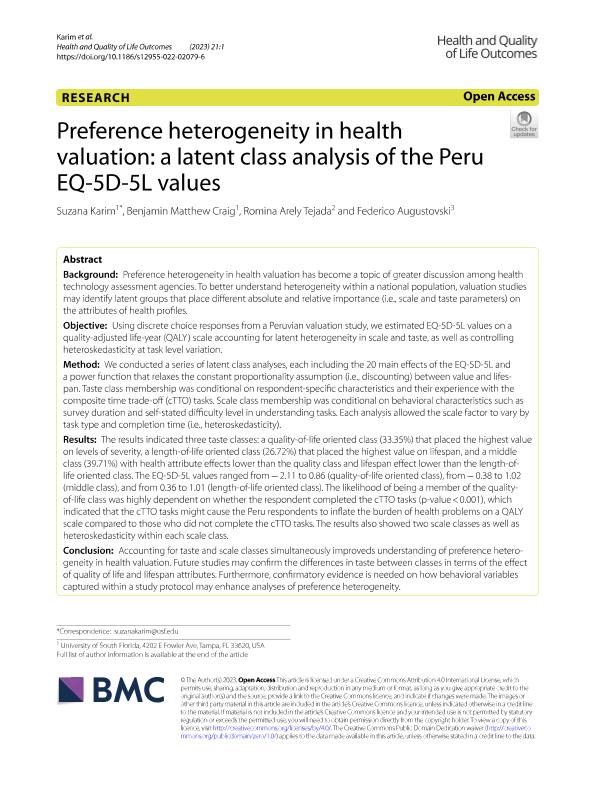Artículo
Preference heterogeneity in health valuation: a latent class analysis of the Peru EQ-5D-5L values
Fecha de publicación:
12/2023
Editorial:
BioMed Central
Revista:
Health and Quality of Life Outcomes
ISSN:
1477-7525
Idioma:
Inglés
Tipo de recurso:
Artículo publicado
Clasificación temática:
Resumen
Background: Preference heterogeneity in health valuation has become a topic of greater discussion among health technology assessment agencies. To better understand heterogeneity within a national population, valuation studies may identify latent groups that place different absolute and relative importance (i.e., scale and taste parameters) on the attributes of health profiles. Objective: Using discrete choice responses from a Peruvian valuation study, we estimated EQ-5D-5L values on a quality-adjusted life-year (QALY) scale accounting for latent heterogeneity in scale and taste, as well as controlling heteroskedasticity at task level variation. Method: We conducted a series of latent class analyses, each including the 20 main effects of the EQ-5D-5L and a power function that relaxes the constant proportionality assumption (i.e., discounting) between value and lifespan. Taste class membership was conditional on respondent-specific characteristics and their experience with the composite time trade-off (cTTO) tasks. Scale class membership was conditional on behavioral characteristics such as survey duration and self-stated difficulty level in understanding tasks. Each analysis allowed the scale factor to vary by task type and completion time (i.e., heteroskedasticity). Results: The results indicated three taste classes: a quality-of-life oriented class (33.35%) that placed the highest value on levels of severity, a length-of-life oriented class (26.72%) that placed the highest value on lifespan, and a middle class (39.71%) with health attribute effects lower than the quality class and lifespan effect lower than the length-of-life oriented class. The EQ-5D-5L values ranged from − 2.11 to 0.86 (quality-of-life oriented class), from − 0.38 to 1.02 (middle class), and from 0.36 to 1.01 (length-of-life oriented class). The likelihood of being a member of the quality-of-life class was highly dependent on whether the respondent completed the cTTO tasks (p-value < 0.001), which indicated that the cTTO tasks might cause the Peru respondents to inflate the burden of health problems on a QALY scale compared to those who did not complete the cTTO tasks. The results also showed two scale classes as well as heteroskedasticity within each scale class. Conclusion: Accounting for taste and scale classes simultaneously improveds understanding of preference heterogeneity in health valuation. Future studies may confirm the differences in taste between classes in terms of the effect of quality of life and lifespan attributes. Furthermore, confirmatory evidence is needed on how behavioral variables captured within a study protocol may enhance analyses of preference heterogeneity.
Archivos asociados
Licencia
Identificadores
Colecciones
Articulos(CIESP)
Articulos de CENTRO DE INVESTIGACIONES EN EPIDEMIOLOGIA Y SALUD PUBLICA
Articulos de CENTRO DE INVESTIGACIONES EN EPIDEMIOLOGIA Y SALUD PUBLICA
Citación
Karim, Suzana; Craig, Benjamin Matthew; Arely Tejada, Romina; Augustovski, Federico Ariel; Preference heterogeneity in health valuation: a latent class analysis of the Peru EQ-5D-5L values; BioMed Central; Health and Quality of Life Outcomes; 21; 1; 12-2023; 1-14
Compartir
Altmétricas




